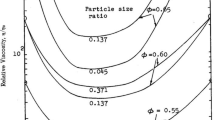Abstract
The rheological behavior of stable slurries is shown to be characterized by a bimodal model that represents a slurry as made up of a coarse fraction and a colloidal size fine fraction. According to the model, the two fractions behave independently of each other, and the non-Newtonian behavior of the viscosity is solely caused by the colloidal fraction, while the coarse fraction increases the viscosity level through hydrodynamic interactions. Data from experiments run with colloidal coal particles of about 2–3 µm average size dispersed in water show the viscosity of these colloidal suspensions to exhibit a highly shearrate-dependent behavior and, in the high shear limit, to match very closely the viscosity of suspensions of uniform size rigid spheres although the coal volume fraction must be determined semi-empirically. Different amounts of coarse coal particles are added to the colloidal suspension and the viscosity of the truly bimodal slurries measured as a function of shear rate. In agreement with the bimodal model, the measured shear viscosities show the coarse fraction to behave independently of the colloidal fraction and its contribution to the viscosity rise to be independent of the shear rate. It is shown that the shear rate exerted on the colloidal fraction is higher than that applied by the viscometer as a result of hydrodynamic interactions between the coarse particles, and that it is this effective higher shear rate which is necessary to apply in the correlations. For determining the coal volume fraction a relatively simple and quite accurate measurement technique is developed for determining the density and void fraction of coarse porous particles; the technique directly relates volume fraction to mass fraction.
Similar content being viewed by others
References
Probstein RF, Sengun MZ (1987) PhysicoChem Hydrodyn 9:299
Krieger IM (1972) Adv Colloid Interface Sci 3:111
Firth BA, Hunter RJ (1976) J Colloid Interface Sci 57:266
Schaller EJ, Humphrey AE (1966) J Colloid Interface Sci 22:573
Krieger IM, Eguiluz M (1976) Trans Soc Rheol 20:29
Chan D, Powell RL (1984) J Non-Newtonian Fluid Mechanics 15:165
Lewis TB, Nielsen LE (1968) Trans Soc Rheol 12:421
Chong JS, Christiansen EB, Baer AD (1971) J Appl Polymer Sci 15:2007
Probstein RF, Sengun MZ (1985) In: Proc 7th Int'nl Symp Coal Slurry Prep & Utilization, PETC, U.S. DOE, New Orleans, pp 115–119
Farris RJ (1968) Trans Soc Rheol 12:281
Sengun MZ, Probstein RF (1989) PhysicoChem Hydrodyn 11:229
Author information
Authors and Affiliations
Rights and permissions
About this article
Cite this article
Sengun, M.Z., Probstein, R.F. Bimodal model of slurry viscosity with application to coal-slurries. Part 1. Theory and experiment. Rheol Acta 28, 382–393 (1989). https://doi.org/10.1007/BF01336805
Received:
Revised:
Issue Date:
DOI: https://doi.org/10.1007/BF01336805




